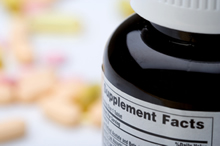Multivitamin 101

By Tory Wegner, LAc
When it comes to vitamins and nutrients, it is best to get them from food, but it can be hard to get adequate amounts due to poor food choices, poor food quality, and not eating enough variety. This is why many people choose to take a multivitamin, just to be on the safe side and ensure that they are providing their body with what it needs. This has lead multivitamins to be the number one supplement sold in America and it is a billion dollar industry. Vitamins come in a variety of forms—tablets, liquids, powders—and it’s hard to know which is the right one to take. It is so easy to get overwhelmed with all the choices and flashy marketing, but it all comes down to being an informed consumer. By understanding how to decipher ingredient labels it will be easy to pick up any vitamin bottle, analyze the quality of it, figure out if it contains any fillers or additives, and decide if it’s worth your money.
When you look at a vitamin label, you’ll see the daily serving size on the top and underneath will be the list of vitamins and minerals contained in the supplement followed by the percent of daily value. Remember, not all vitamins will be 100% of your daily value, because you should be getting it from your food as well. Underneath the list of vitamins and minerals is the ingredient list. This really is the MOST important part to read and understand. It’s easy to breeze over it because the writing is really small and the names are really long. Trying to decipher the label gets confusing and you may feel like you need a chemistry degree to figure out what you’re actually getting.
The reason the ingredients section is so important is because this is the place the manufacturers have to list the fillers and additives and “inactive” ingredients they use to make the supplement. Never forget that companies are out to make a profit, so they will use cheap ingredients, synthetic ingredients, and harmful chemicals to make their products and then use misleading language, so you don’t know what you are consuming! The additives are broken down into 5 main categories: fillers, binders, coatings, lubricants, and preservatives. I’m going to break each of these down and give you the names of the common culprits to look for and to AVOID on the ingredients list (see list below). Print this out and compare it to your vitamin or take it with you to the store when you are shopping and READ LABELS!! Hang in there, if you need help, you can always bring the bottles or ingredient list into the office and let your practitioner help you.
Fillers and additives are such a big deal because they are synthetically made chemicals that human bodies are not designed to consume. After looking over the list you’ll see familiar names like wood pulp, tin, titanium, and sand…these are not things I would want to purposefully put into my body or pay money for, especially when I’m taking a multivitamin to “be healthy.”
On a more positive note, there are many manufacturers who don’t use fillers and additives in their multivitamins. They make “whole foods” based multivitamins, which means that the vitamins are derived from actual quality foods (mainly fruits and vegetables) versus vitamins manufactured in a lab. The bottles will usually clearly say that the vitamin is made from food and the ingredient list will be things like spinach, kale, blueberries etc. Since the companies are not adding fillers and additives, the price of the vitamin is going to be more, but the quality is worth the investment. The Whole Foods market has a large vitamin selection to choose from, and most are quality vitamins. The website vitacost.com is also a good resource to search for quality vitamins at a discounted price. Be an informed consumer by asking lots of questions, reading labels, and doing research to make sure you are taking a multivitamin that is supporting your efforts to be healthy.
Fillers: are added so the supplement can be formed into a tablet that is big enough or stable enough to hold it’s shape. Common Names: Lactose, microcrystalline cellulose (derived from wood pulp), cornstarch, sugars (sucrose, mannitol, sorbitol, fructose, dextrose etc), whey, and yeast.
Binders: sticky/gluey substances that hold the pills together. Common Names: Povidone, xantham gum, gelatin and carbopol
Coatings: help hold the tablet together so it doesn’t break apart in the mouth. They also mask unpleasant tastes and often contain colorants. Common Names: Dyes are labeled FD&C followed by a color name, often yellow and red, titanium dioxide (titanium)
Lubricants: assist the manufacturing process in releasing tablets from the tablet-forming machines. Common Names: Magnesium stearate, stearic acid, sodium stearyl fumarate, polyethylene glycol (carbowax), hypromellose, soy lecithin, and hydrogenated vegetable oils (palm, sunflower etc.)
Preservatives: prevent the growth of bacteria and mold and prevent the ingredients from spoiling. Common Names: Silicon dioxide (sand), calcium propuinate, sodium nitrate, sulfites, BHA or BHT (butylated hydroxytoluene possible carcinogen), salt (sodium metavanadate, molybdate, selenate or aluminosilicate), stannous chloride (tin salt), ascorbyl palmite


